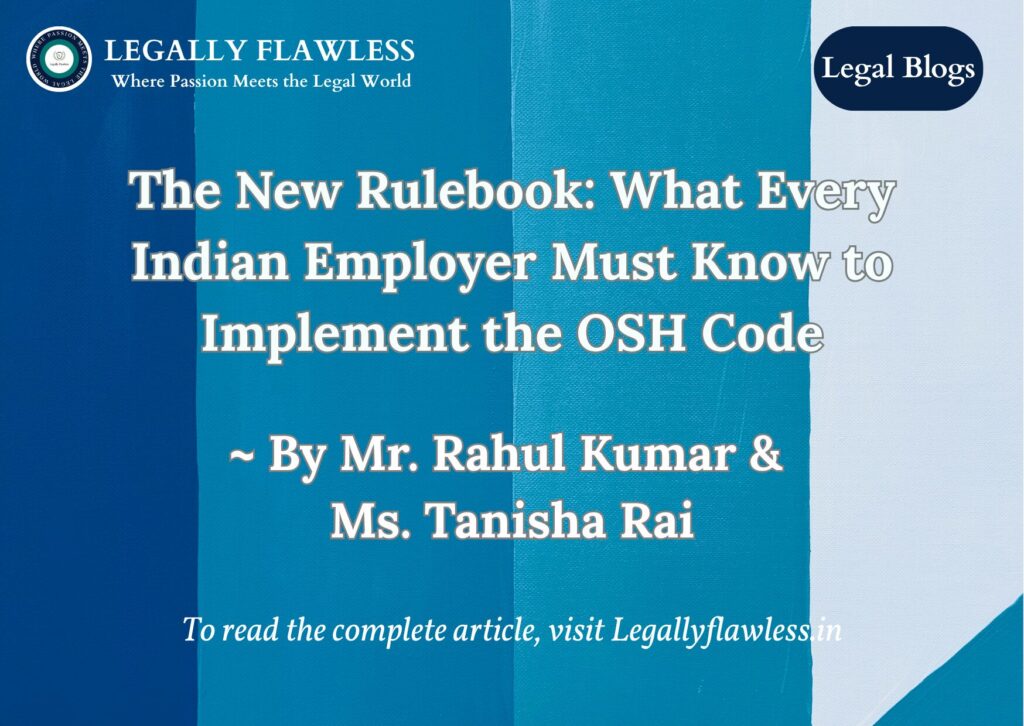
Table of Contents
Introduction
The Occupational Safety, Health and Working Conditions Code, 2020 (OSH Code), represents the most comprehensive reform in Indian labour law in decades. It is not merely an amendment; it’s the consolidation of 13 separate Central labour laws into a single, unified framework designed to simplify compliance while dramatically expanding worker protections. For Indian employers, this transition is both a strategic challenge and a significant opportunity. The Code’s primary goal is to universalise the concepts of safety, health, and welfare, extending basic protections to millions of workers previously excluded, particularly those in the unorganised sector or in modern IT and service establishments. Compliance with this new Code is non-negotiable; getting it right prevents severe financial and legal penalties and, more importantly, fosters a secure, motivated, and productive workforce. It must be noted, however, that while the OSH Code, 2020, has been enacted, its enforcement awaits the final notification by the Central Government.
OSH Code’s Expanded Scope: Understanding Who is Covered
The initial step in achieving compliance involves clearly defining the Code’s reach, as its applicability has been significantly broadened. The OSH Code applies to nearly every establishment employing 10 or more workers, immediately bringing many small and medium-sized enterprises (SMEs), which were often outside the scope of older industrial and factory laws, under its strict compliance requirements. This means offices, IT firms, small service sector companies, and modern warehouses must now adhere to the Code’s comprehensive safety and welfare mandates. Crucially, the definition of a “worker” has also been expanded to explicitly include categories of employees often previously overlooked, such as contract workers, inter-state migrant workers, audio-visual workers, and journalists. This places a clear, unified legal responsibility on the principal employer for the working conditions of everyone on their premises, regardless of their employment contract.
1. Mandatory Unified Registration and Licensing
Under the OSH Code, the era of managing a cumbersome portfolio of disparate licenses and registrations is coming to an end. The legislation strongly advocates for a move toward a single, unified electronic registration system, providing every covered establishment with a unique identification number accessible across all labour enforcement agencies. This simplification aims to drastically reduce bureaucratic delays and make compliance monitoring more efficient. For those engaging contract workers, the process for obtaining and renewing a contractor’s license, as well as the principal employer’s registration of the specific contract work, is being unified and digitized. Employers should immediately prioritize training their HR and compliance teams on the new digital platform to ensure their establishment’s registration is current and seamless, as failure here will be an early and easy target for non-compliance penalties.
2. Comprehensive Safety and Health Audits
The OSH Code demands a substantial shift from reactive, inspection-based compliance to a proactive system of self-governance and prevention. Employers must conduct a thorough, documented Safety and Health Audit across all their premises, which encompasses far more than just basic fire safety drills. This audit must systematically identify and mitigate risks related to high-risk machinery operation, the handling of hazardous substances, ventilation and ambient environmental conditions, and the promotion of good ergonomics in office and factory settings. Furthermore, establishments involved in hazardous processes are mandated to appoint a sufficient number of certified Safety Officers and provide periodic and compulsory medical examinations for all workers involved. This ensures continuous risk management and prioritizes the long-term health and well-being of the workforce.
3. Overhauling Working Hours and Annual Leave Policies
The new Code introduces critical flexibility for employers and employees while requiring strict adherence to overall limits, necessitating an immediate review of HR, payroll, and time management systems. While the standard remains a maximum of 48 hours per week, the Code offers the flexibility to implement a 4-day work week, provided the daily working hours are increased (up to 12 hours) and the employer secures the written consent of the concerned employees. This flexibility must be managed meticulously to ensure strict compliance with rest day requirements and total weekly working limits. Beyond hours, policies governing annual leave accrual must be updated; specifically, the minimum number of days required to be worked by a new employee to qualify for annual leave has been revised, and the rules concerning the carry-forward and encashment of accumulated leave have been standardised to ensure parity across different industries.
4. New Norms for Women Employment
One of the most significant and progressive shifts in the OSH Code is the complete removal of historical legislative barriers that previously restricted women from certain types of work or work timings. Women can now be employed in all types of establishments, all classes of work, and during any time of the day or night, including late night shifts. This landmark move toward gender parity, however, imposes clear, accountable mandates on the employer. The employer must secure the written consent of the woman employee for night shift work and is legally required to provide adequate safety measures, security, and reliable transportation facilities from their residence to the workplace and back. These mandated provisions ensure that the removal of barriers is coupled with robust protections for safety and dignity.
5. Managing Contract and Migrant Workers’ Welfare
The OSH Code places a clear, unavoidable responsibility on the Principal Employer for the basic safety and welfare of all workers on their premises, irrespective of their contract status. The onus is placed on the principal employer to ensure that contract workers are provided with adequate welfare facilities, including clean restrooms, first-aid equipment, and access to drinking water, standardizing their working conditions with those of permanent employees. Furthermore, special attention is drawn to Inter-State Migrant Workers, defined by the Code based on their originating state and earning threshold. For these workers, the employer is legally obligated to provide a journey allowance for travel to the workplace from their place of engagement and ensure the provision of suitable welfare measures in both their working and housing arrangements, making their employment more regulated and secure.
6. Mandating Welfare Facilities: Crèches and Canteens
Welfare provisions, which were often considered non-mandatory employee benefits, are now codified as statutory requirements for many establishments. Employers must immediately review their total workforce strength, as the requirement for providing dedicated crèche facilities for the children of employees has been extended to establishments with a specific, potentially lower, number of workers (the exact threshold will be detailed in the final State rules). Similarly, the Code details mandatory standards for providing clean canteens, adequate washing and locker facilities, first-aid rooms, and appropriate seating arrangements, standardizing what constitutes a healthy and compliant working environment across the country. These provisions reflect a recognition that worker productivity is inextricably linked to their overall well-being.
7. Digitisation and Unified Record-Keeping
The OSH Code strongly promotes digitisation and transparency, mandating that all required records and registers be maintained in a unified, electronic format. Employers must transition all traditional physical registers including Muster Rolls, wage registers, and leave registers to a unified, electronic record-keeping system. This shift is not merely procedural; it enables rapid compliance audits and ensures records are immediately accessible to inspecting authorities. Poor or fragmented documentation is historically the most common reason for penalties during an inspection, and the push for digital, standardised records under the OSH Code means employers must invest in robust, compliant HR management software immediately to avoid legal exposure.
8. Penalties for Non-Compliance
The OSH Code prescribes strict penalties to ensure compliance. For instance, failure to adhere to safety and health requirements can attract fines up to ₹2 lakhs for employers, with additional penalties for continued contraventions. Serious violations leading to accidents or worker harm may even result in imprisonment. Importantly, the Code also provides for compounding of certain offences to enable quicker resolution, but repeat offenders face enhanced penalties. This clear framework underscores that non-compliance is not only a reputational risk but also a significant financial and legal liability.
Conclusion: The Urgency of Proactive Implementation
The OSH Code, 2020, is a fundamental and irreversible restructuring of the rules governing safety and welfare in India. It pushes for digitisation, transparency, and a unified approach, replacing decades of legislative complexity. The key takeaway for every Indian employer is the urgency of a proactive internal audit. Waiting for the final notification of implementation rules is a costly mistake. Businesses must immediately engage their HR, Legal, and Facilities teams to systematically work through this checklist: updating registrations, auditing safety infrastructure, revising employment contracts to reflect new working hour rules, and ensuring compliance with the gender equality mandates. Compliance with the OSH Code is not merely a legal obligation; it is a vital investment in human capital and the long-term operational stability and reputation of your business.
The article is authored by Mr. Rahul Kumar and Ms. Tanisha Rai, students at the Institute of Law, Nirma University, Ahmedabad.
All efforts are made to ensure the accuracy and correctness of the information published at Legally Flawless. However, Legally Flawless shall not be responsible for any errors caused due to oversight or otherwise. The users are advised to check the information themselves.


